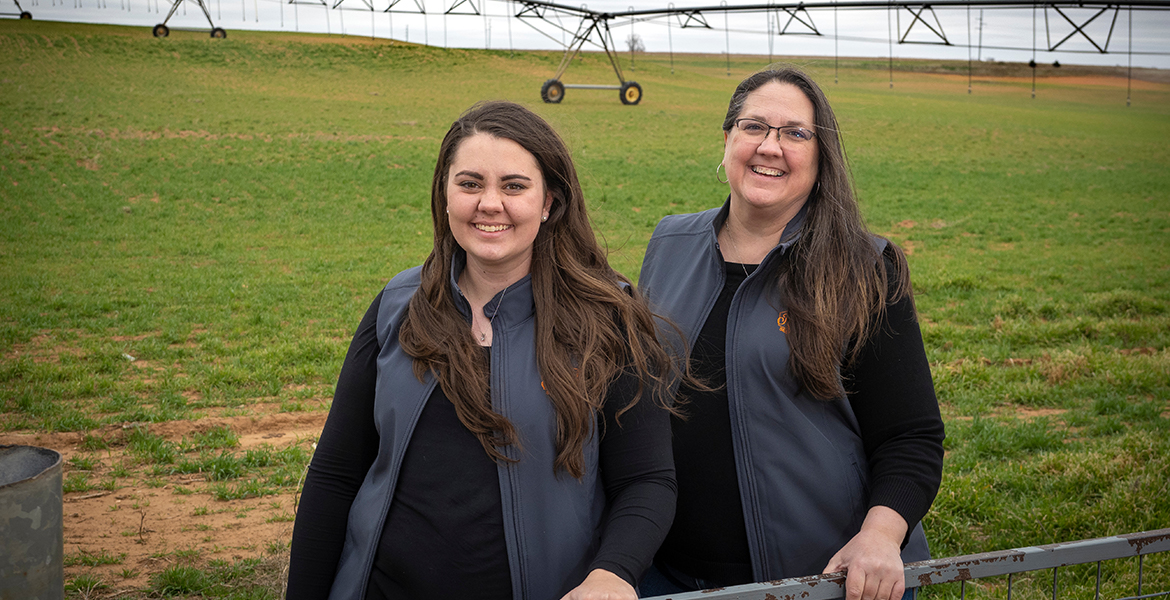
Women in agriculture gaining recognition long deserved
Tuesday, March 16, 2021
Based on the latest Census of Agriculture and organizational hierarchy charts throughout the industry, it might seem as though women have been stepping into more ag leadership roles in recent years.
The truth is, they’ve been there all along, from farm to board room, said Brittany Hukill and other Oklahoma State University alumnae who know first-hand.
“Not only do we have female producers, but women are the voice of agriculture on a much larger stage as well,” said Hukill at her family’s fifth-generation farm near Hydro, Oklahoma. Hukill is the owner/manager of Krehbiel Farms LLC, running daily operations and irrigation sales with her mother, Karen Krehbiel Dodson.
“I have always known there is a place for women in agriculture, in large part thanks to my dad and grandpa teaching me to think that way. And there have been a lot of strong women in my life who have helped pave the way for others to come after them,” the OSU graduate said.
The census conducted by the U.S. Department of Agriculture in 2017 revealed that 36% of the nation’s farmers are women, and about 56% of all farms have at least one key, female, decision-maker.
Those numbers are a stark contrast to the USDA’s previous survey. While the number of male producers fell about 2% to 2.17 million from 2012 to 2017, the number of female producers increased by 27% to 1.23 million.
The data is collected every five years; the department is already developing its 2022 census. Part of the reason for the large difference since 2012 is due to how the USDA’s National Agricultural Statistics Service reworded the survey from earlier efforts. Officials asked better questions, which revealed what women like Heather Buckmaster already knew.
“When you look at my board, nearly half are women. The chair is a woman,” said Buckmaster, an OSU graduate in agricultural economics and Oklahoma Beef Council executive director since 2005. “You’re going to find something similar across other commodities as well, although I think cattle is one of the most diverse. I take a little pride in that.”
She cited Terry Stuart Forst, also an OSU alum, as another example of a historic woman in leadership. In 2008, the head of 7S Stuart Ranch in Caddo became the first woman president of the Oklahoma Cattlemen’s Association.
Buckmaster credited her own father for helping to break cultural gender roles by working with her on the family ranch in Hydro, although he might not have realized it then. She surprised her boyfriend the first time she jumped out of the pickup truck on a date to open and close a gate – it simply made sense at the time because a task needed doing.
As for women like herself setting an example for others to come later, she said, “When you see someone who looks like you making key decisions and making a difference, it creates a drive and desire to succeed as well.”
Hukill said she farmed alongside her grandfather when her father died. She came back to the family operation after graduating OSU with a degree in agricultural economics in 2017. Both men treated her with the respect of someone who could do anything as well as they could.
In college, Hukill met yet another Hydro native and OSU alum, Minnie Lou Bradley, who earned her degree in 1953 at what was then known as Oklahoma Agricultural & Mechanical College. Bradley became the first woman to enroll in animal husbandry at OA&M and went on to become a big name in Angus cattle.
“She has also been a big encouragement, always telling me, ‘Ladies can do it; they can do anything,’” Hukill said. “And then when Blayne Arthur took over as secretary of agriculture, I took that as a personal affirmation of that idea. It doesn’t always have to be men in leadership.”
Arthur, the first woman to head the state Department of Agriculture, agreed that female authority figures empower those coming up behind. Cultural change across history is not as simple as a light switch, and role models exist at all levels of the industry, from small home operations to large corporations and government.
Women might have been overlooked in previous census data because of the nature of agriculture in Oklahoma, she said: The majority of farms in the state are small, family operations and usually passed through the generations. Mothers and daughters work alongside fathers and sons as a single unit to get the work done – delivering calves, picking up tractor parts in town, closing down the barn in a storm, balancing the accounting books – so taking credit doesn’t come naturally.
“I don’t think it’s ever been intentional in the ag sector. As long as you want to show up and work hard and be part of a team, women are very much respected in agriculture. I think it’s just a very humble demographic,” said Arthur, who earned an agricultural economics degree at OSU.
“We’re only really starting to recognize it, but women have had a significant impact in agriculture for a long, long time,” the Chickasha native said, “Women have always been an integral part of our farming and ranching operations and always will.
MEDIA CONTACT: Brian Brus | Agricultural Communications Services | 405-744-6792 | BBrus@okstate.edu
